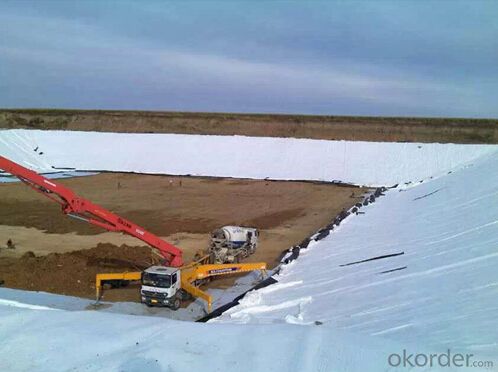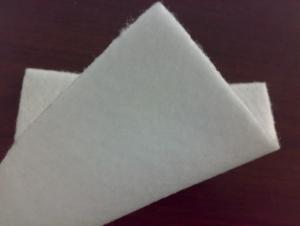PP or PET Non woven Polyester Geotextile Used in Construction
- Loading Port:
- Qingdao
- Payment Terms:
- TT OR LC
- Min Order Qty:
- 10000 m²
- Supply Capability:
- 30000000 m²/month
OKorder Service Pledge
OKorder Financial Service
You Might Also Like
Specifications of Geotextile
Non-woven geotextil price for road
1.CE and ISO
2.elogation ratio:25-100
3.CBR bursting strength :0.3-4.0
Application of Geotextile
1. Filtration
The filtration layer of the dykes, river canal, seacoast, concrete slope, retaining walls. At the same time of preventing the clay granule from passing, it allows the water and the gas pass through freely.
2. Separation
The isolation of the railway dregs and the roadbed, roadbed and the soft base, surface of the airdrome and parking lot and the groundsill, different dam materials. It isolates the soil and the gravel of two kinds different granule pathway from the groundsill or other buildings.
3. Reinforcement
The highway, railway, soilstone dam, breakwater, airport, backfill soil of retaining wall, slope protection, etc in which distributes the earth stress, prevents the side-displacement of the earth body and improves the earth body stability.
4. Protection
It prevents the bank from being washed out, protects the bank and the bottom, prevents the water and soil from being washed away.
Woven geotextile :
Made from polypropylene and or polyester fibers, manufactured with high tensile strength and low elongation, our woven geotextiles have superior properties for filtration, separation, reinforcement, erosion control and drainage. We are leader in providing woven geotextiles for a variety of civil and environmental applications including highways, port facilities, reservoir, transport construction, waste and chemical management ,subgrade engineering, coast reclamation works, peninsula shoal engineering.
Properties of Multifilament Woven Geotextile
Metric and British conversions:
1kn/m------around68.57lbs/ft 1oz/yd2---around 33.9g/m2 1m------around 3.3ft
Physical properties | Test method | Unit | Typical Value | ||||||||||
Material | Polypropylene/PP | ||||||||||||
Unit Weight | ASTM D 5261 | g/m2 | 200 | 300 | 400 | 500 | 600 | 700 | 800 | 900 | 1300 | ||
Color | White | ||||||||||||
Tensile Strength at break MD | ASTM D 4595 | KN/M >= | 50 | 75 | 100 | 130 | 160 | 180 | 200 | 230 | 360 | ||
Tensile Strength at break CD | ASTM D 4595 | KN/M >= | 35 | 52 | 70 | 90 | 112 | 126 | 140 | 160 | 280 | ||
Elongation at break MD | ASTM D 4595 | % <=< span=""> | 35 | 35 | 35 | 35 | 35 | 35 | 35 | 35 | 35 | ||
Elongation at break CD | ASTM D 4595 | % <=< span=""> | 30 | 30 | 30 | 30 | 30 | 30 | 30 | 30 | 30 | ||
CBR Puncture Strength | ASTM D 6241 | KN | 4 | 6.9 | 10.5 | 14 | 18 | 20.5 | 23 | 24 | 28 | ||
Tear Strength | ASTM D 4533 | KN | 0.6 | 1 | 1.3 | 1.55 | 1.9 | 2 | 2.2 | 2.3 | 3.2 | ||
Permitivity | ASTM D 4491 | S-1 | 0.01-0.8 | ||||||||||
Pore opening size O90 | ASTM D 4751 | mm | 0.06-0.7 | ||||||||||
Width: max 3.8m, standard 3.6m. Other colors available. | |||||||||||||
Physical properties | Test method | Unit | Typical Value | |||||||
Material | Polyester/PET | |||||||||
Color | White | |||||||||
Tensile Strength at break MD | ASTM D 4595 | KN/M | 100 | 150 | 150 | 200 | 400 | 300 | 500 | 1000 |
Tensile Strength at break CD | ASTM D 4595 | KN/M | 50 | 50 | 150 | 50 | 50 | 300 | 100 | 50 |
Elongation at break MD | ASTM D 4595 | % | <=15< span=""> | |||||||
Elongation at break CD | ASTM D 4595 | % | <=15< span=""> | |||||||
Permitivity | ASTM D 4491 | S-1 | 0.01-0.8 | |||||||
Pore opening size O90 | ASTM D 4751 | mm | 0.06-0.7 | |||||||
Notes:
1)The property values listed are gained in our laboratories .The right is reserved to make changes without any notice
2)Mechanical properties, origin materials, width, roll length can be adjusted to different applications.
Geotextile Products Show:








FAQ:
- Q: What can we do for the special customer?
A: Provide custom made service with customer's drawing; We make sure to provide you with the best solutions for your individual case. Whether standard items or non-standard items.
- Q: What can we supply?
A: We provide high levels of communication from start to finish.
- Q: What is our advantage?
A: Top Cemented Carbide has extensive business experience, Fast delivery and high quality.
- Q: What are the ingredients of PL?
- PL is a polyester fabric.PL is the abbreviation of English polyester for polyester fiber. Polyester fiber is an important variety of synthetic fiber, and it is the commodity name of polyester fiber in our country.
- Q: What material is the Gong Duan?
- Twill: the warp and weft are interleaved at least once between the 1 yarns, i.e., 2, 1, or 3. The fabric structure is changed by adding warp and weft points, which is called twill fabric. This kind of cloth is characterized by its relatively thick and strong three-dimensional structure. There are 30 branches, 40 branches and 60 branches.
- Q: What is the general ladies sweater fabric
- Ladies knitwear fabric, blended wool fiber flax.
- Q: Fabric composition of clothing is made of viscose rayon, is what?
- In recent years, and the emergence of a viscose Tencel, bamboo fiber, high-grade new varieties. But regardless of how changes are still in viscose cotton or other natural fiber as raw material to produce cellulosic fiber. You know, viscose is a very historic ancient fiber varieties. As early as the end of nineteenth Century, the scientists made the sodium cellulose xanthate solution first to cotton as raw material, the solution viscosity is very large, so this glue is named in the viscose viscose, encounter acid produced after the reaction, the cellulose is again separated. It was later on the basis of this principle that cellulose fibers were produced by this reaction. Later, in order to realize the workProduction, scientists have invented a dilute sulfuric acid and sulfate using the solidified product composition, so as to realize the mass production of viscose fiber, also have a lot of what we see at present by the viscose fiber being produced beautiful, cool clothes.
- Q: What kind of clothes do you wear cool in summer?!
- Summer clothes naturally want to wear cool and healthy, therefore, the choice of material is very important.Cicada's silk is the coolestPure cotton is also very good. Because cotton cloth attracts sweat. If you are a sweaty person, it will be comfortable to wear pure cotton clothesColor is also important. Light colorsWearing red is the most effective against UV rays
- Q: Will the clothes of polyester fabrics fade?
- Polyester fiber belongs to chemical fiber, and its coloring degree is much higher than natural fiber,General polyester fabrics require more than 3.5 color fastness, and NIKE and other well-known brands of polyester fabric color fastness requirements to more than 4. Color fastness of more than four polyester products, light colored cleaning almost fade, and dark (such as black, red, Navy, etc.) will be slightly faded
- Q: What are the TR fabrics and advantages?
- (1) high strength, short fiber strength 2.6~5.7Cn/dtex, high strength fiber is 5.6~8.0Cn/dtex. due to the lower moisture absorption, wet strength and its dry strength is basically the same, the impact strength is 4 times higher than nylon, 20 times higher than that of viscose fiber.(2) good elasticity, elastic to wool, when the elongation of 5%~6%, almost completely restored, wrinkle resistance than other fibers, namely the fabric wrinkle, good dimensional stability, elastic modulus was 22~141cN/dtex, 2~3 times higher than nylon.(3) good water absorption.(4) good wear resistance, wear resistance is second only to wear resistance nylon, better than other natural fiber and synthetic fiber.(5) good light resistance, light resistance is second only to acrylic fiber.(6) corrosion resistance, resistance to bleaching agent, oxidant, Jinghe, ketones, petroleum products and inorganic acid, alkali resistant not mildew, but hot alkali can decompose the.
- Q: What are high count high yarn fabrics?
- High count cotton is cotton texture, no cotton, no chemical fiber cloth, is generally 30, 40 and 60. If 30 78*65 stands for 1 square centimeters, the longitude and latitude density is 143 (78+65). 40 110*90 stands for 1 square centimeters, and the warp and weft density is 200 (110+90). Bedding, such as wool quilt, DUVET QUILT, etc., are usually made of 40 133*72 fabric to prevent drilling and running.
- Q: What cloth is the shirt made of?
- Ordinary shirts are made of fabrics, usually made of cotton and synthetic fibers, which are then woven into yarn. This fabric will be relatively hard, when washing, it is obvious not to hang water (chemical fiber does not absorb water).
- Q: What fabric pilling?
- If it is pure cotton, it is generally not easy to pilling, and sometimes mixed with other fibers, it is easy to pilling.
Send your message to us
PP or PET Non woven Polyester Geotextile Used in Construction
- Loading Port:
- Qingdao
- Payment Terms:
- TT OR LC
- Min Order Qty:
- 10000 m²
- Supply Capability:
- 30000000 m²/month
OKorder Service Pledge
OKorder Financial Service
Similar products
Hot products
Hot Searches






























